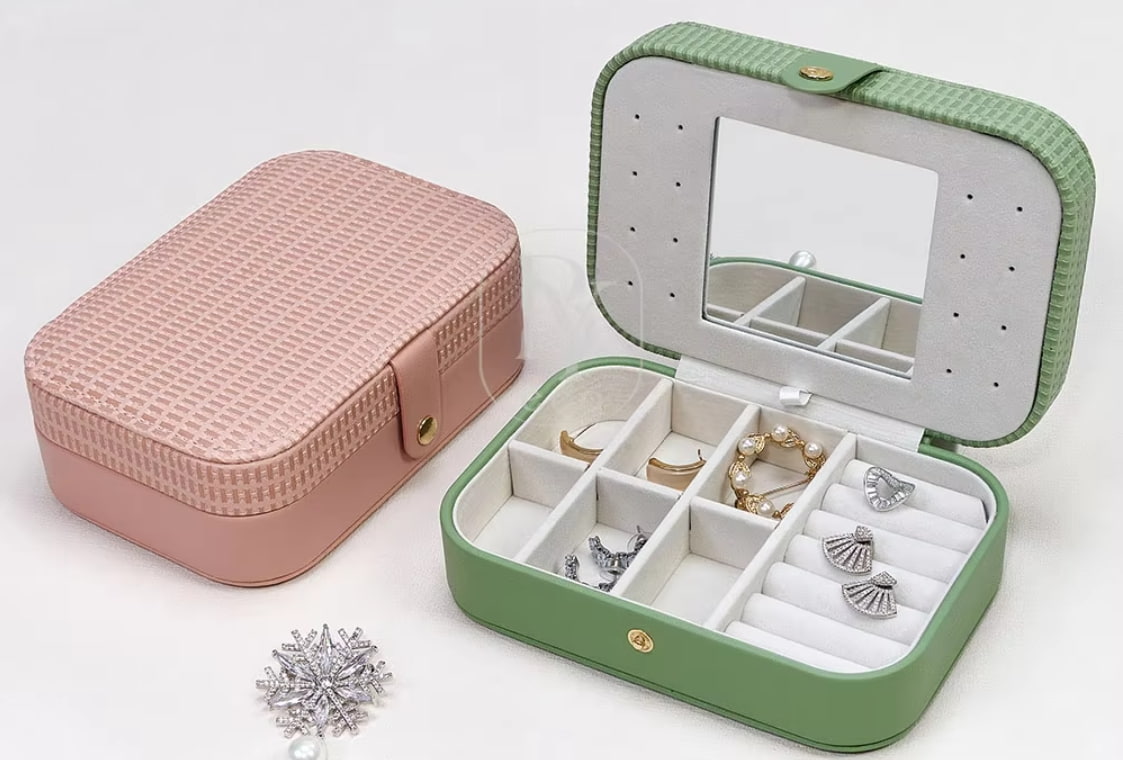You can share
- Share to Facebook
- Share to Google+
- Subscribe to our
- Share to Linkedin
- Share to Twitter

In the jewelry industry, leather jewelry boxes are not only containers for protecting precious jewelry, but also important carriers of brand image and user experience. As the core component of jewelry boxes, linings directly affect the safe storage, beautiful display, and user's tactile experience of jewelry. Next, we will explore the best lining selection for leather jewelry boxes based on material characteristics, functional requirements, and audience preferences.
Before selecting lining materials, it is necessary to clarify the three core functions that they need to meet:
(1) Physical protection: prevent jewelry from being damaged by friction, oxidation, or humidity.
(2) Visual aesthetics: enhance the display effect of jewelry through color and texture.
(3) Tactile comfort: the feel when opening and closing the jewelry box directly affects the user experience.
In addition, the lining must also take into account environmental protection (avoid chemical corrosion of jewelry) and durability (no deformation after long-term use).
(1) Silk - a synonym for luxury and classic
Advantages:
- Natural luster and softness, highlighting the luxury of jewelry.
- Low friction coefficient, suitable for inlaid jewelry (such as diamonds, gemstones), avoiding scratches.
- Good air permeability, reducing the risk of metal oxidation.
Disadvantages:
- Easy to absorb dust, needs to be cleaned regularly.
- It is high-cost and suitable for high-end customized models.
- Applicable scenarios: wedding jewelry boxes and luxury brand customized series.
(2) Velvet - the first choice for balanced cost performance
Advantages:
- Delicate short velvet touch, providing a "buffering protective layer", especially suitable for soft metals such as pearls and gold.
- A variety of color options, customizable brand colors (such as dark blue and burgundy to enhance the sense of luxury).
- Moderate cost, better durability than silk.
Disadvantages:
- Easy to produce indentations after long-term use, and needs to be coordinated with the support structure design.
- Static electricity may absorb fine dust.
- Applicable scenarios: mid-to-high-end mass-produced jewelry boxes, daily storage models.
(3) Microfiber Leather - A combination of technology and environmental protection
Advantages:
- Waterproof and stain-resistant, easy to clean (just wipe with a damp cloth).
- Strong wear resistance, suitable for frequently used commercial display boxes.
- Can imitate the texture of genuine leather, and the cost is lower than natural materials.
Disadvantages:
- Poor air permeability, long-term sealed storage requires desiccant.
- Some low-end synthetic materials may release volatile substances.
- Applicable scenarios: fast-moving consumer goods brands, temporary display boxes at exhibitions.
(4) Vegetable-Tanned Leather - A niche, high-end, innovative choice
Advantages:
- Form a unified texture with the leather outer box, and strengthen the brand tone (such as retro, handcrafted style).
- Natural antibacterial properties, suitable for preserving easily oxidized materials such as silver jewelry.
Disadvantages:
- Requires regular maintenance (applying leather oil), and the maintenance cost is high.
- The initial leather smell may affect the user experience.
- Applicable scenarios: designer brands, art jewelry series.
(5) Environmentally friendly recycled materials (such as bamboo fiber, degradable PU) - future trend
Advantages:
- In line with the concept of sustainable development, attracting consumers with strong environmental awareness.
- The new bamboo fiber material has both antibacterial and breathable properties.
Disadvantages:
- Insufficient market awareness and large cost fluctuations.
- Durability is still in the verification stage.
- Applicable scenarios: green brands, young market promotion.

(1) Jewelry type
Precious metals (gold, platinum): Prioritize anti-oxidation materials (such as flannel + sealing strip design).
Inlaid gemstones: Low-friction lining is required (silk or microfiber).
Pearl/coral: Avoid water-absorbing materials and choose pH-neutral synthetic leather.
(2) Usage scenarios
Retail display: emphasize visual impact, choose high-contrast color velvet (such as black lining diamonds).
Personal collection: focus on long-term protection, recommend multi-layer partition + moisture-proof lining.
(3) Brand positioning
- Luxury brand: silk/natural leather + hand-stitching craftsmanship.
- Light luxury brand: customized color velvet + hot stamping LOGO.
- Affordable brand: cost-effective synthetic leather + modular design.
Case 1: Tiffany & Co. classic blue gift box uses customized silk lining. User survey shows that its "opening ceremony" promotes a 12% increase in the repurchase rate.
Case 2: Domestic emerging brand "Fanshi" uses bamboo fiber lining and successfully enters the Z generation market. The search volume on the official website increased by 30%.
Data insights: 78% of consumers believe that the texture of the lining directly affects the judgment of the value of jewelry.
(1) Smart lining: embedded humidity/temperature sensors, connected to a mobile phone APP to warn of environmental changes.
(2) Replaceable design: users can replace lining modules according to seasons or jewelry types (such as moisture-proof models in summer).
(3) Cross-border materials: cooperate with fragrance brands to launch lining layers that release essential oils slowly.
The lining of a leather jewelry box is by no means a "supporting role", but an emotional bond between the product and the user. Practitioners need to break away from the single-function thinking and optimize their choices from multiple dimensions of material science, consumer psychology, and brand narrative. For consumers, it is advisable to pay attention to the details of the lining when purchasing - it not only protects the brilliance of the jewelry, but also reflects the care and value behind each piece of jewelry.